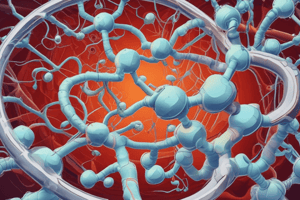Podcast
Questions and Answers
What type of specificity allows an enzyme to act on only one kind of functional group?
What type of specificity allows an enzyme to act on only one kind of functional group?
- Stereospecificity
- Group specificity (correct)
- Absolute specificity
- Linkage specificity
Which mechanism of catalysis involves an enzyme using side chains to donate or accept protons?
Which mechanism of catalysis involves an enzyme using side chains to donate or accept protons?
- Covalent catalysis
- Proximity
- Acid-base catalysis (correct)
- Metal ion catalysis
What role does Zn²⁺ play in the function of carbonic anhydrase?
What role does Zn²⁺ play in the function of carbonic anhydrase?
- It acts as an enzyme's active site template
- It increases the overall thermodynamics
- It forms covalent bonds with substrates
- It stabilizes the negative charge and polarizes water molecules (correct)
Which statement best describes transition state stabilization?
Which statement best describes transition state stabilization?
Which type of specificity refers to an enzyme's ability to selectively catalyze one stereoisomer over another?
Which type of specificity refers to an enzyme's ability to selectively catalyze one stereoisomer over another?
In enzyme reactions, what is primarily affected when increasing the concentration of substrate?
In enzyme reactions, what is primarily affected when increasing the concentration of substrate?
Which mechanism involves amino acid side chains forming temporary covalent bonds with substrates?
Which mechanism involves amino acid side chains forming temporary covalent bonds with substrates?
Which mechanism of enzyme action is NOT relevant for isomerases?
Which mechanism of enzyme action is NOT relevant for isomerases?
What happens to enzyme synthesis when tryptophan levels are high?
What happens to enzyme synthesis when tryptophan levels are high?
Which mechanism prevents self-digestion of digestive enzymes?
Which mechanism prevents self-digestion of digestive enzymes?
How does phosphorylation affect glycogen synthase and glycogen phosphorylase?
How does phosphorylation affect glycogen synthase and glycogen phosphorylase?
What role does ATP play in the function of Aspartate Transcarbamoylase?
What role does ATP play in the function of Aspartate Transcarbamoylase?
What is a characteristic of multifunctional enzymes?
What is a characteristic of multifunctional enzymes?
Which of the following statements regarding allosteric control is true?
Which of the following statements regarding allosteric control is true?
What is the effect of decreasing lactose consumption after weaning on lactase enzyme synthesis?
What is the effect of decreasing lactose consumption after weaning on lactase enzyme synthesis?
What is the primary reason for the cleavage of chymotrypsinogen into active α-chymotrypsin?
What is the primary reason for the cleavage of chymotrypsinogen into active α-chymotrypsin?
What is the role of the aspartic acid side chain in the catalytic triad of chymotrypsin?
What is the role of the aspartic acid side chain in the catalytic triad of chymotrypsin?
What does a lower Km value indicate about an enzyme's substrate affinity?
What does a lower Km value indicate about an enzyme's substrate affinity?
In the context of enzyme kinetics, what occurs when the substrate concentration exceeds Km?
In the context of enzyme kinetics, what occurs when the substrate concentration exceeds Km?
What is the function of the electrostatic catalysis in the enzymatic reaction described?
What is the function of the electrostatic catalysis in the enzymatic reaction described?
Which step in chymotrypsin's mechanism involves the formation of a tetrahedral transition state?
Which step in chymotrypsin's mechanism involves the formation of a tetrahedral transition state?
What effect does a saturated enzyme have on the rate of reaction as substrate concentration increases?
What effect does a saturated enzyme have on the rate of reaction as substrate concentration increases?
Which factor is CRUCIAL for maintaining the pH during the enzymatic reaction involving bicarbonate?
Which factor is CRUCIAL for maintaining the pH during the enzymatic reaction involving bicarbonate?
What reaction does lysozyme primarily catalyze through acid-base catalysis?
What reaction does lysozyme primarily catalyze through acid-base catalysis?
Flashcards
Enzyme Stereospecificity
Enzyme Stereospecificity
Enzymes' ability to selectively catalyze reactions of one stereoisomer over another.
Enzymatic Absolute Specificity
Enzymatic Absolute Specificity
An enzyme catalyzes only one specific reaction.
Enzyme Group Specificity
Enzyme Group Specificity
Enzymes that act on a specific functional group of a molecule.
Enzyme Linkage Specificity
Enzyme Linkage Specificity
Signup and view all the flashcards
Enzyme Catalytic Power
Enzyme Catalytic Power
Signup and view all the flashcards
Activation Energy
Activation Energy
Signup and view all the flashcards
Enzyme Proximity Effect
Enzyme Proximity Effect
Signup and view all the flashcards
Acid-Base Catalysis
Acid-Base Catalysis
Signup and view all the flashcards
Gene Expression Regulation (e.g., Trp, Lac)
Gene Expression Regulation (e.g., Trp, Lac)
Signup and view all the flashcards
Zymogen Activation
Zymogen Activation
Signup and view all the flashcards
Covalent Modification
Covalent Modification
Signup and view all the flashcards
Feedback Inhibition
Feedback Inhibition
Signup and view all the flashcards
Allosteric Regulation
Allosteric Regulation
Signup and view all the flashcards
Allosteric Effector
Allosteric Effector
Signup and view all the flashcards
Multifunctional Enzyme
Multifunctional Enzyme
Signup and view all the flashcards
Blood Clotting Cascade
Blood Clotting Cascade
Signup and view all the flashcards
What is the role of OH- in carbonic anhydrase?
What is the role of OH- in carbonic anhydrase?
Signup and view all the flashcards
How does lysozyme catalyze the breakdown of bacterial cell walls?
How does lysozyme catalyze the breakdown of bacterial cell walls?
Signup and view all the flashcards
What is the catalytic triad in chymotrypsin?
What is the catalytic triad in chymotrypsin?
Signup and view all the flashcards
How does chymotrypsin hydrolyze polypeptides?
How does chymotrypsin hydrolyze polypeptides?
Signup and view all the flashcards
What is a covalent acyl enzyme intermediate?
What is a covalent acyl enzyme intermediate?
Signup and view all the flashcards
What are the assumptions of Michaelis-Menten kinetics?
What are the assumptions of Michaelis-Menten kinetics?
Signup and view all the flashcards
What is Vmax?
What is Vmax?
Signup and view all the flashcards
What is Km?
What is Km?
Signup and view all the flashcards




